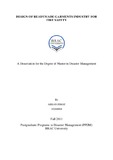| dc.contributor.advisor | Mallick, Fuad H. | |
| dc.contributor.author | Firoz, Ahsan | |
| dc.date.accessioned | 2012-05-24T05:05:53Z | |
| dc.date.available | 2012-05-24T05:05:53Z | |
| dc.date.copyright | 2011 | |
| dc.date.issued | 2011 | |
| dc.identifier.other | ID 10268004 | |
| dc.identifier.uri | http://hdl.handle.net/10361/1818 | |
| dc.description | This dissertation is submitted in partial fulfillment of the requirements for the degree of Master in Disaster Management, 2011. | |
| dc.description | Cataloged from PDF version of Dissertation. | |
| dc.description | Includes bibliographical references (page 89- 91). | |
| dc.description.abstract | In Bangladesh businesses are growing at an ever fast rate. New businesses are opening everyday in every possible sector. Taking purchasing power parity into account Bangladesh is the 44th largest economy in the world. Bangladesh is also listed in the N-11 (next 11) by the Goldman Sachs Group, Inc. Among all the industries, at present textiles and readymade garments‟ industry are the top ones. Recently WTO has ranked Bangladesh as the 4th largest exporter of readymade garments‟ in the world. This sector contributes for 75% of foreign currency earning for Bangladesh. Textiles and Readymade Garments‟ sector contributes 13% of GDP and employs more than 3,000,000 people. It has bought benefit and blessings for millions of people in the country. This industry has played a significant role in elevating economic and living standard of millions of families all over the country. Along with bringing blessing for the nation, textile and RMG industry also hold the record of experiencing some worst industrial accidents in the country. Taking advantage of poor surveillance of concerned authorities‟ rules, laws and codes are often violated in construction sector of our country and factory buildings are no exception. It is popularly believed and often proven true by incidences that the building codes are only maintained in paper works and hardly during the construction phase. Later as the owner focuses on the interior works, machine placement etc. the floors are often over loaded with machineries, causing more population load during operational hours, narrowing circulation spaces, thus making it difficult for the people to access the emergency route during an emergency. Many factories do not arrange regular drill; therefore the workers discover themselves in an alien situation whenever an emergency situation arises, causing panic, stampede etc. that further escalate the degree of casualty. In the conditions as above the aforementioned thesis is proposed to evaluate the design of garments factories from a safety point of view especially in case of a fire out. The dissertation would focus on literatures, expert interviews and case study on previous incidence to find out the major reasons for casualty in case of fire in a RMG factory. The dissertation would than contain some software simulation with space syntax depthmap to evaluate the validity of the findings and would propose suggestions to alleviate the chances of casualty in RMG factories especially in case of fire. | en_US |
| dc.description.statementofresponsibility | Ahsan Firoz | |
| dc.format.extent | 103 pages | |
| dc.language | en | |
| dc.publisher | BRAC University | en_US |
| dc.rights | BRAC University dissertation are protected by copyright. They may be viewed from this source for any purpose, but reproduction or distribution in any format is prohibited without written permission. | |
| dc.subject | Disaster management | |
| dc.subject | Ready made garments | |
| dc.subject | Fire safety | |
| dc.title | Design of readymade garments industry for fire safety | en_US |
| dc.type | Dissertation | en_US |
| dc.contributor.department | Department of Architecture, BRAC University | |
| dc.description.degree | M. Disaster Management | |

